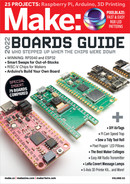
planning and strategy. Instead of just hiring
more hardware engineers, the company has
invested in expert analysts to help forecast and
meet demand. New boards are being designed
to permit easy substitution of parts with
similar footprints or even multiple footprints
to accommodate availability, so they can easily
switch production back to the original/full-
featured product should a missing component
suddenly become available again.
Since Arduino control their whole ecosystem,
part substitutions — like switching a 9-axis
IMU to discrete 6- and 3-axis components —
can often be made transparently by updating
the board definition or library. Sometimes,
however, the required changes are more drastic,
and necessitate a product variant such as the
Portenta Lite, which lacks the NXP security chip
found on the original. Fortunately, thanks to
their mission as a learning community, Arduino
occasionally receives favors from suppliers who
would rather see what few chips they can source
end up in schools rather than buried in less
virtuous applications.
Other than a few advanced processes (for
example 8-layer PCBs), most Arduino products
are still made in Piedmont, Italy, near their
headquarters in Turin. In order to provide the
highest level of support for all these variants,
Arduino have worked serial numbers into their
products, for traceability from PCB to release, as
well as making boards easily identifiable visually
so that support staff can immediately confirm the
specifics from a user-supplied picture. Arduino’s
significant investment in automated testing of
software and hardware also facilitates hardware
variants, since they can ship with confidence
that a slight mutation from the original product
will still work with all the different libraries and
sketches.
Thanks to their adaptations, Arduino have
actually increased deliveries compared to
pre-pandemic levels. Although Arduino, and
even their suppliers, continue to have difficulty
forecasting the supply chain, they assure us
they’ll keep fighting to bring us the products we
want and love. [For an example, check out the
brand new Make Your Uno kit on page 47.]
NOW BOARDING: Supply Snafus
PI VERSUS .PY
Adafruit Industries have been so impacted
by the chip shortage that they wrote a little
jingle and created a web series about it! Having
encountered supply issues early on, they were
able to quickly pivot to an availability-first design
methodology for new products, instead of
designing for manufacturing and relying on just-
in-time inventory.
Another advantage is Adafruit’s significant
investment in Python as a hardware
programming language. Not only does their
extensive support for CircuitPython make getting
into hardware development more accessible, but
it also means incredible portability across boards
and architectures. With their Blinka library, even
single-board computers can get in on the act,
with full CircuitPython API support meaning that
the same code that runs on your Feather and QT
Py can easily move back and forth to Raspberry
Pi, BeagleBone, Jetson, and ClockworkPi.
Watch Adafruit’s Chip Shortage
series and get the theme tune stuck
in your head: youtube.com/hashtag/
chipshortage
38 makezine.com
David Ray
M83_036-41_SS_ScarceChips_F1.indd 38M83_036-41_SS_ScarceChips_F1.indd 38 10/10/22 1:25 PM10/10/22 1:25 PM
..................Content has been hidden....................
You can't read the all page of ebook, please click here login for view all page.
